USS ASTORIA CA-34
The Official Home of 'Nasty Asty'
Rising Sun in the East 1937

CLICK PHOTO TO ENLARGE
Imperial Japanese Navy SNLF (Special Naval Landing Forces) against the backdrop of Mt. Fuji. This photograph was taken during 1937 maneuvers as tensions with China continued to escalate.
-Imperial Japanese Navy photo from Brent Jones collection

CLICK PHOTO TO ENLARGE
IJN Special Naval Landing Forces sailors pose on the grounds of the Imperial Palace in Tokyo. Behind them is a statue of legendary samurai Kusunoki Masashige, representative of the Bushido spirit rising in influence from an increasingly militaristic government.
-Imperial Japanese Navy photo from Brent Jones collection

CLICK PHOTO TO ENLARGE
The Marine Detachment aboard USS ASTORIA circa 1937.
-U.S. Navy photo from Brent Jones collection
While tensions increased between China and Japan throughout early 1937, America continued to train for war scenarios with Japan. The annual gathering of the U.S. Navy for Fleet Problem XVIII in April-May 1937 again simulated operations against the Imperial Japanese Navy. The exercise staged from Lahaina Roads and Pearl Harbor in Hawaii. USS ASTORIA participated along with her new assignment--Cruiser Division 6, Scouting Force.

CLICK PHOTO TO ENLARGE
USS ASTORIA CA-34 leads INDIANAPOLIS CA-35 in column circa 1937.
-U.S. Navy photo from NARA collection 80-G-456497
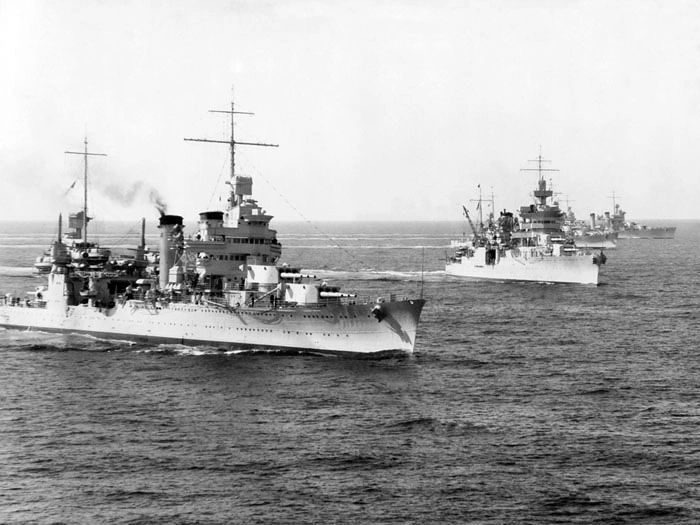
CLICK PHOTO TO ENLARGE
USS ASTORIA (left) conducting maneuvers with INDIANAPOLIS CA-35, SAN FRANCISCO CA-38,
and NEW ORLEANS CA-32 circa 1937. Note that the ships' anchors have been painted black, perhaps a measure used to identify ships in the Black Force during the Fleet Problem.
-U.S. Navy photo from NARA collection 80-G-456499
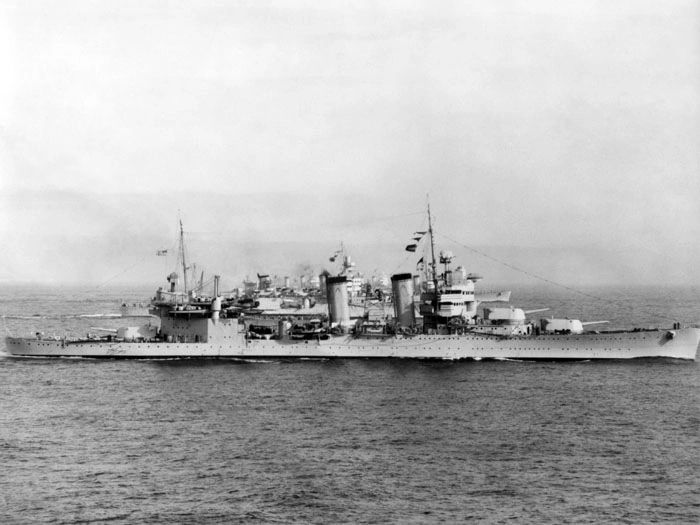
CLICK PHOTO TO ENLARGE
USS ASTORIA CA-34 (foreground) conducting maneuvers with other cruisers circa 1937. This image appears to have been taken in sequence with the previous photograph.
-U.S. Navy photo from NARA collection 80-G-456498

The third commanding officer of USS ASTORIA CA-34, Captain Charles C. Gill. He assumed
command of the ship on 15 March 1937.
-photo from Brent Jones collection

On 27 May 1937, USS ASTORIA was one of several ships present in San Francisco Bay for the opening ceremonies of the Golden Gate Bridge.
-photo from Brent Jones collection
In July 1937, ASTORIA was one of 18 U.S. Navy ships that participated in the Pacific Fleet Fiesta as part of the annual Portland Rose Festival. This large naval presence sailed up the Columbia and Willamette Rivers into Portland, Oregon beginning 16 July.
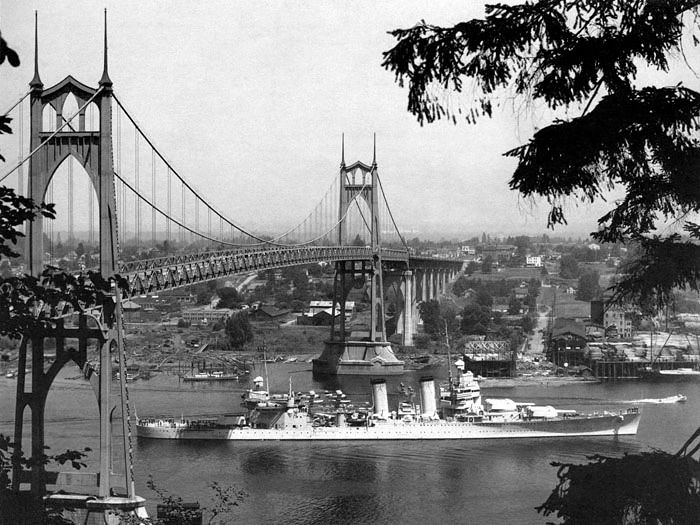
CLICK PHOTO TO ENLARGE
USS ASTORIA CA-34 steams under the St. Johns Bridge spanning the Willamette River, 16 July 1937.
-photo from Brent Jones collection
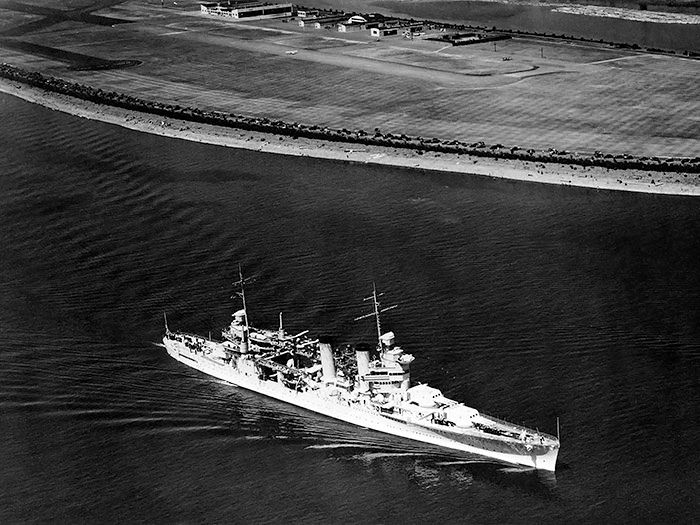
CLICK PHOTOS TO ENLARGE
Aerial views of USS ASTORIA entering Portland. Above: The heavy cruiser passes Swan Island Airport. Note the cars and spectators lining the length of the island.
Below: The large number 34 is visible atop ASTORIA's number two main battery turret. This system for aerial identification appears to have been used only during 1936-37.
-photos from Brent Jones collection


CLICK PHOTO TO ENLARGE
USS ASTORIA passes through the draw of Broadway Bridge in the Willamette River, 16 July 1937.
-photo from Brent Jones collection
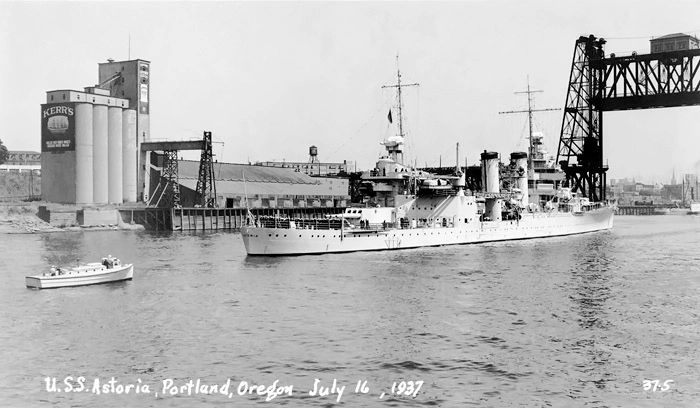
CLICK PHOTO TO ENLARGE
Above: USS ASTORIA passes under the lift of Steel Bridge as she approaches her berth along the south bank of the Willamette River, 16 July 1937.
Below: in a close-up from this image, ASTORIA sailors muster on the fantail as spectators watch from the riverbank.
-photo from Brent Jones collection

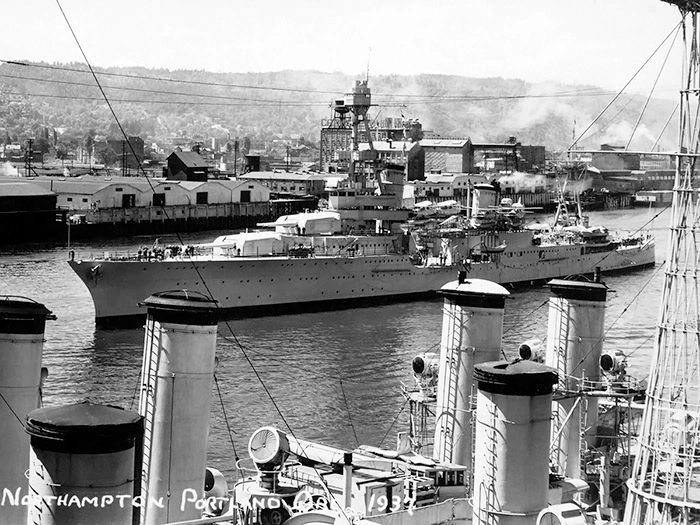
CLICK PHOTO TO ENLARGE
USS NORTHAMPTON CA-26 joins the festivities. In the foreground, two destroyers are moored alongside museum ship USS OREGON BB-03. Like ASTORIA, NORTHAMPTON would be lost during the naval battles of Guadalcanal in 1942.
-photo from Brent Jones collection
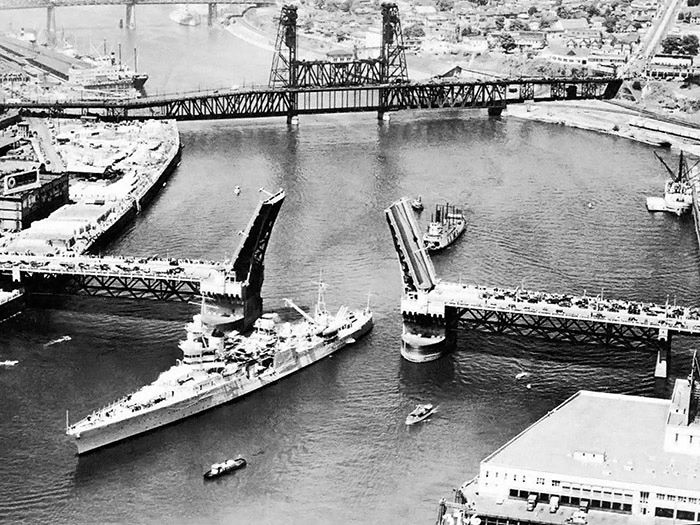
USS INDIANAPOLIS CA-35 passes through the draw of Burnside Bridge. The waterfront at left between the two bridges is where ASTORIA moored. Like the other cruisers shown above, INDIANAPOLIS would not survive World War Two.
-photo from Brent Jones collection
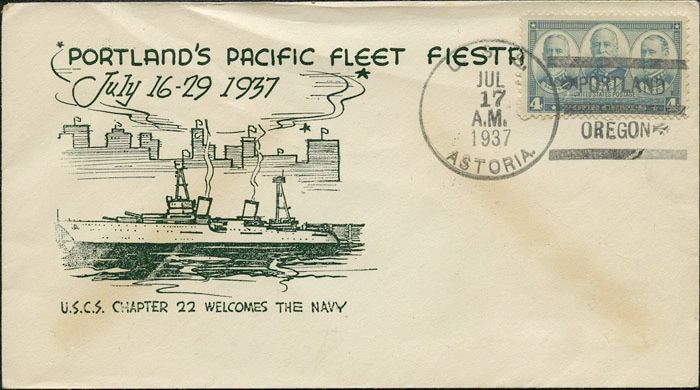
A philatelic collector's envelope with a USS ASTORIA postal cancel from 17 July 1937.
-from Brent Jones collection
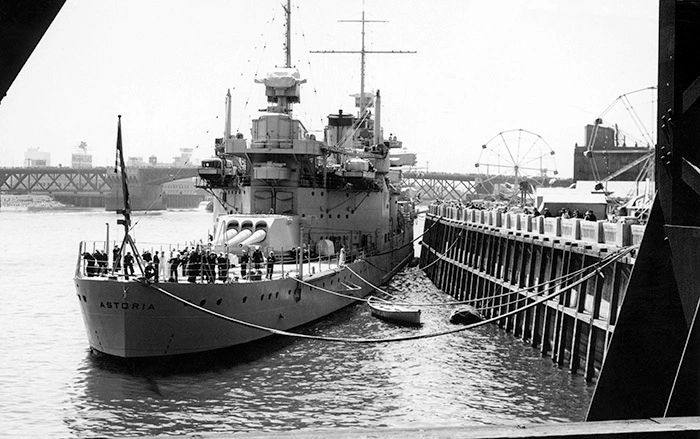
CLICK PHOTO TO ENLARGE
USS ASTORIA moored in the Willamette River where she spent more than a week open to the public for tours. Taken from Steel Bridge on 17 July 1937. Burnside Bridge is in the background.
-photo from Brent Jones collection
By the time festivites drew to a close in Portland, escalating hostilities across the Pacific in China were leading to full-scale invasion by Japan. Within weeks urban fighting was taking place in Shanghai, and the two nations were at war.

CLICK PHOTO TO ENLARGE
In strong contrast to the U.S. Navy images from Portland, Japanese warships pay a very different type of visit to Shanghai in August 1937. The stern of flagship IJN YAEYAMA is photographed from the cruiser IZUMO in Shanghai Harbor. Smoke drifts skyward in the background from the siege of the city.
-Imperial Japanese Navy photo from Brent Jones collection

CLICK PHOTO TO ENLARGE
Imperial Japanese Navy cruisers utilized floatplanes in the same manner as their American counterparts. In this image taken from IZUMO in Shanghai Harbor, a Nakajima E8N is hoisted aboard ship following a mission. Note the two members of the aircrew, one of which has hooked the plane to the recovery boom visible at upper right.
-Imperial Japanese Navy photo from Brent Jones collection

CLICK PHOTO TO ENLARGE
Special Naval Landing Forces troops in a Shanghai street in driving rain during the August 1937 fighting. Note the Japanese flag attached to one sailor's Type 38 rifle.
-Imperial Japanese Navy photo from Brent Jones collection
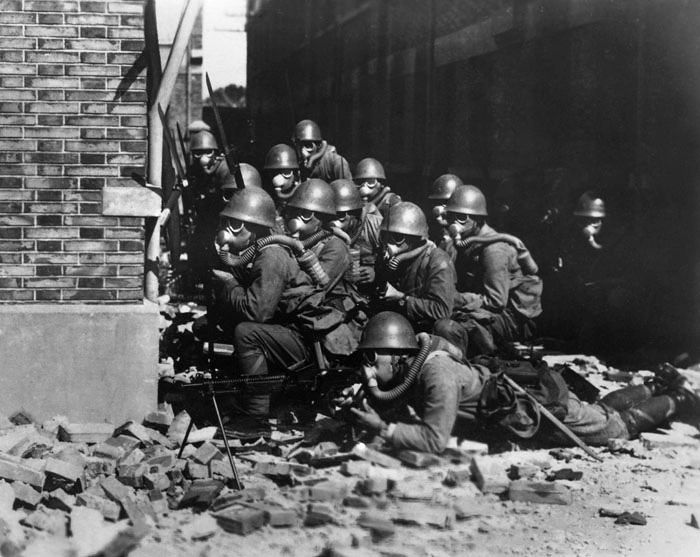
CLICK PHOTO TO ENLARGE
IJN Special Naval Landing Forces troops in gas masks prepare for an advance in the rubble of Shanghai. Chemical weapons were utilized against the Chinese during the battle.
-Imperial Japanese Navy photo from Brent Jones collection
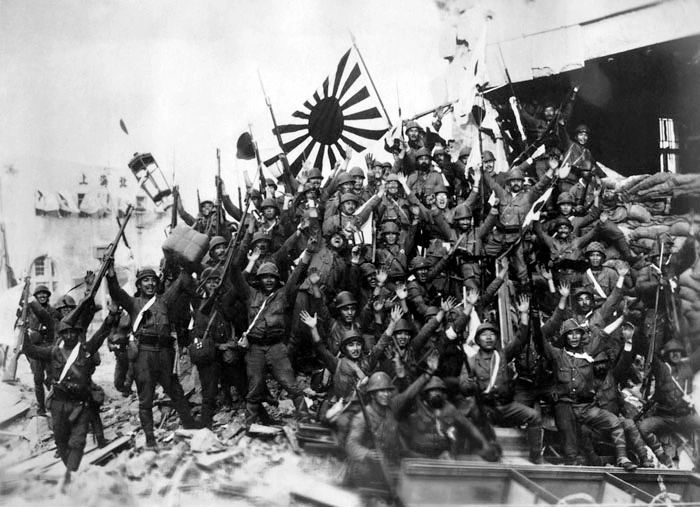
CLICK PHOTO TO ENLARGE
IJN Special Naval Landing Forces sailors celebrate their 1937 Shanghai victory with euphoric cries of "Banzai!" Note the officer at center with sword pointed skyward.
-Imperial Japanese Navy photo from Brent Jones collection
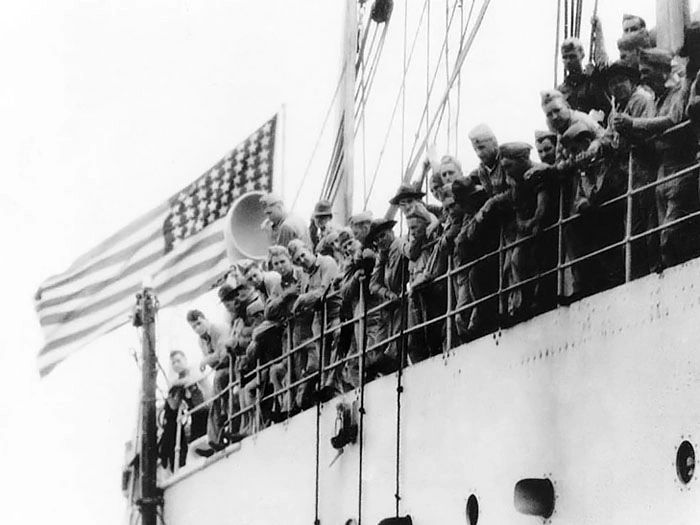
U.S. Marines from the 6th Regiment aboard USS CHAUMONT AP-5 arriving in Shanghai Harbor, 19 September 1937. Although technically neutral in the conflict, USMC reinforcements were rushed to China to protect American citizens living in the International Settlement.
-U.S. Navy photo from Naval History and Heritage Command collection NH 77950
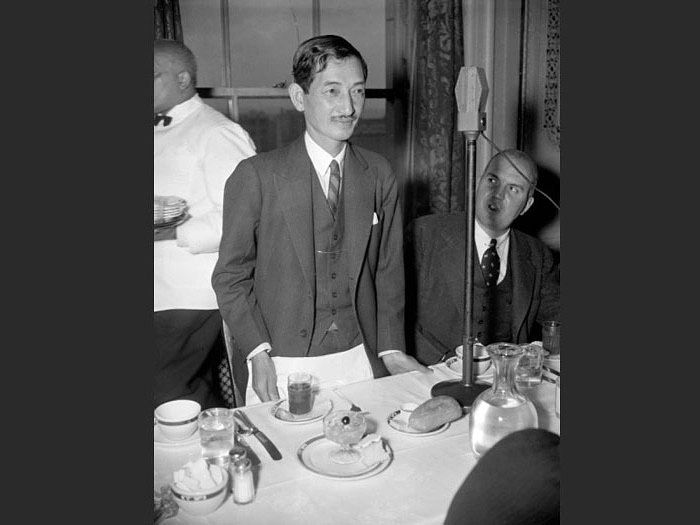
Japanese Ambassador Hirosi Saito at a Washington press club luncheon on 14 October 1937. Saito, who did not personally support his government's aggressive policies in China, performed a difficult balancing act with the American press.
-photo from Brent Jones collection
By early December, Japanese forces were closing in on the Chinese capital city of Nanking. On 11 December, American embassy staff were evacuated on American gunboats including USS PANAY PR-5. PANAY moved up the Yangtze River escorting three American merchant tankers. The next day, despite clear American markings and flags, PANAY was attacked by Japanese aircraft. She was bombed and endured repeated strafing runs. Three men were killed, with 43 Sailors and five civilians wounded in the attack. USS PANAY sunk in the Yangtze River.
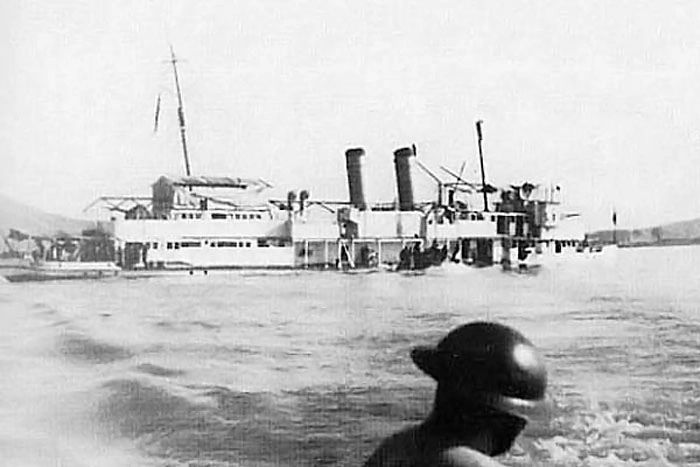
PANAY crew members are ferried to shore in launches as the gunboat begins to list to starboard following attacks on 12 December 1937.
-photo reproduced from www.hmsfalcon.com
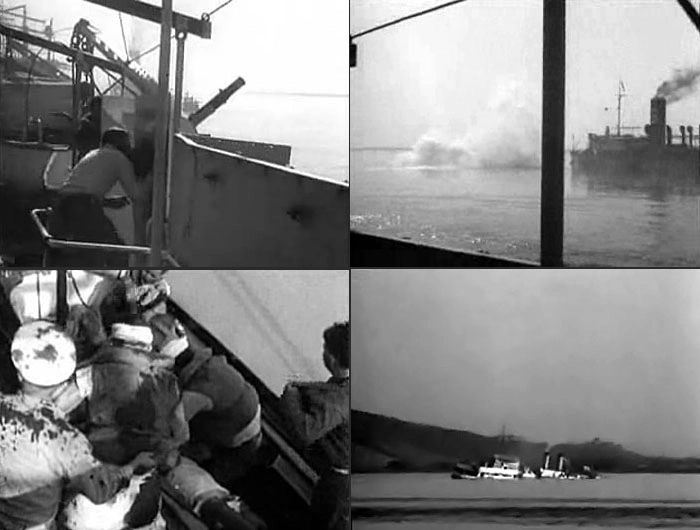
Eric Mayell of Fox Movietone was one of two news photographers who shot film footage from aboard the PANAY during the attack. Much of this footage was shown in American newsreels in the weeks following the attack. Despite official apologies, public outrage toward Japan began to grow.
-still frames reproduced from film footage at www.hmsfalcon.com
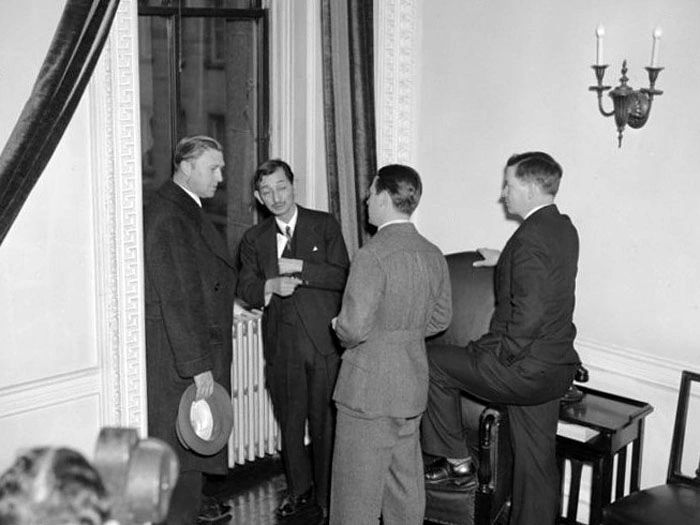
Hirosi Saito is cornered by reporters as he waits to speak to the U.S. Secretary of State the day after the incident, 13 December 1937. Saito was outspoken in his criticism of his military's invasive practices in China, and he fell into further disfavor with his government over his apologetic handling of the sinking of USS PANAY.
-photo from Brent Jones collection
Sources
HMS FALCON website. www.hmsfalcon.com
Jones, Brent. Private photo and document collection.
Jones, Pat (ed.) The USS ASTORIA (CA-34) and the Men Who Sailed Her. USS ASTORIA Reunion Association. Privately printed, 1992.
Mooney, James L. (ed.) Dictionary of American Naval Fighting Ships. Washington, D.C.: Naval History Division, 1958-1981.
National Archives and Records Administration. http://www.archives.gov/research/
Naval History and Heritage Command Photographic Section. http://www.history.navy.mil/
Nofi, Albert A. To Train the Fleet for War: The U.S. Navy Fleet Problems. Newport, RI: Naval War College Press, 2010.
Continue to Northwest to Alaska 1938

BACK TO USS ASTORIA HOMEPAGE

CLICK PHOTO TO ENLARGE
Imperial Japanese Navy SNLF (Special Naval Landing Forces) against the backdrop of Mt. Fuji. This photograph was taken during 1937 maneuvers as tensions with China continued to escalate.
-Imperial Japanese Navy photo from Brent Jones collection

CLICK PHOTO TO ENLARGE
IJN Special Naval Landing Forces sailors pose on the grounds of the Imperial Palace in Tokyo. Behind them is a statue of legendary samurai Kusunoki Masashige, representative of the Bushido spirit rising in influence from an increasingly militaristic government.
-Imperial Japanese Navy photo from Brent Jones collection

CLICK PHOTO TO ENLARGE
The Marine Detachment aboard USS ASTORIA circa 1937.
-U.S. Navy photo from Brent Jones collection
While tensions increased between China and Japan throughout early 1937, America continued to train for war scenarios with Japan. The annual gathering of the U.S. Navy for Fleet Problem XVIII in April-May 1937 again simulated operations against the Imperial Japanese Navy. The exercise staged from Lahaina Roads and Pearl Harbor in Hawaii. USS ASTORIA participated along with her new assignment--Cruiser Division 6, Scouting Force.

CLICK PHOTO TO ENLARGE
USS ASTORIA CA-34 leads INDIANAPOLIS CA-35 in column circa 1937.
-U.S. Navy photo from NARA collection 80-G-456497

CLICK PHOTO TO ENLARGE
USS ASTORIA (left) conducting maneuvers with INDIANAPOLIS CA-35, SAN FRANCISCO CA-38,
and NEW ORLEANS CA-32 circa 1937. Note that the ships' anchors have been painted black, perhaps a measure used to identify ships in the Black Force during the Fleet Problem.
-U.S. Navy photo from NARA collection 80-G-456499

CLICK PHOTO TO ENLARGE
USS ASTORIA CA-34 (foreground) conducting maneuvers with other cruisers circa 1937. This image appears to have been taken in sequence with the previous photograph.
-U.S. Navy photo from NARA collection 80-G-456498

The third commanding officer of USS ASTORIA CA-34, Captain Charles C. Gill. He assumed
command of the ship on 15 March 1937.
-photo from Brent Jones collection

On 27 May 1937, USS ASTORIA was one of several ships present in San Francisco Bay for the opening ceremonies of the Golden Gate Bridge.
-photo from Brent Jones collection
In July 1937, ASTORIA was one of 18 U.S. Navy ships that participated in the Pacific Fleet Fiesta as part of the annual Portland Rose Festival. This large naval presence sailed up the Columbia and Willamette Rivers into Portland, Oregon beginning 16 July.

CLICK PHOTO TO ENLARGE
USS ASTORIA CA-34 steams under the St. Johns Bridge spanning the Willamette River, 16 July 1937.
-photo from Brent Jones collection

CLICK PHOTOS TO ENLARGE
Aerial views of USS ASTORIA entering Portland. Above: The heavy cruiser passes Swan Island Airport. Note the cars and spectators lining the length of the island.
Below: The large number 34 is visible atop ASTORIA's number two main battery turret. This system for aerial identification appears to have been used only during 1936-37.
-photos from Brent Jones collection


CLICK PHOTO TO ENLARGE
USS ASTORIA passes through the draw of Broadway Bridge in the Willamette River, 16 July 1937.
-photo from Brent Jones collection

CLICK PHOTO TO ENLARGE
Above: USS ASTORIA passes under the lift of Steel Bridge as she approaches her berth along the south bank of the Willamette River, 16 July 1937.
Below: in a close-up from this image, ASTORIA sailors muster on the fantail as spectators watch from the riverbank.
-photo from Brent Jones collection


CLICK PHOTO TO ENLARGE
USS NORTHAMPTON CA-26 joins the festivities. In the foreground, two destroyers are moored alongside museum ship USS OREGON BB-03. Like ASTORIA, NORTHAMPTON would be lost during the naval battles of Guadalcanal in 1942.
-photo from Brent Jones collection

USS INDIANAPOLIS CA-35 passes through the draw of Burnside Bridge. The waterfront at left between the two bridges is where ASTORIA moored. Like the other cruisers shown above, INDIANAPOLIS would not survive World War Two.
-photo from Brent Jones collection

A philatelic collector's envelope with a USS ASTORIA postal cancel from 17 July 1937.
-from Brent Jones collection

CLICK PHOTO TO ENLARGE
USS ASTORIA moored in the Willamette River where she spent more than a week open to the public for tours. Taken from Steel Bridge on 17 July 1937. Burnside Bridge is in the background.
-photo from Brent Jones collection
By the time festivites drew to a close in Portland, escalating hostilities across the Pacific in China were leading to full-scale invasion by Japan. Within weeks urban fighting was taking place in Shanghai, and the two nations were at war.

CLICK PHOTO TO ENLARGE
In strong contrast to the U.S. Navy images from Portland, Japanese warships pay a very different type of visit to Shanghai in August 1937. The stern of flagship IJN YAEYAMA is photographed from the cruiser IZUMO in Shanghai Harbor. Smoke drifts skyward in the background from the siege of the city.
-Imperial Japanese Navy photo from Brent Jones collection

CLICK PHOTO TO ENLARGE
Imperial Japanese Navy cruisers utilized floatplanes in the same manner as their American counterparts. In this image taken from IZUMO in Shanghai Harbor, a Nakajima E8N is hoisted aboard ship following a mission. Note the two members of the aircrew, one of which has hooked the plane to the recovery boom visible at upper right.
-Imperial Japanese Navy photo from Brent Jones collection

CLICK PHOTO TO ENLARGE
Special Naval Landing Forces troops in a Shanghai street in driving rain during the August 1937 fighting. Note the Japanese flag attached to one sailor's Type 38 rifle.
-Imperial Japanese Navy photo from Brent Jones collection

CLICK PHOTO TO ENLARGE
IJN Special Naval Landing Forces troops in gas masks prepare for an advance in the rubble of Shanghai. Chemical weapons were utilized against the Chinese during the battle.
-Imperial Japanese Navy photo from Brent Jones collection

CLICK PHOTO TO ENLARGE
IJN Special Naval Landing Forces sailors celebrate their 1937 Shanghai victory with euphoric cries of "Banzai!" Note the officer at center with sword pointed skyward.
-Imperial Japanese Navy photo from Brent Jones collection

U.S. Marines from the 6th Regiment aboard USS CHAUMONT AP-5 arriving in Shanghai Harbor, 19 September 1937. Although technically neutral in the conflict, USMC reinforcements were rushed to China to protect American citizens living in the International Settlement.
-U.S. Navy photo from Naval History and Heritage Command collection NH 77950

Japanese Ambassador Hirosi Saito at a Washington press club luncheon on 14 October 1937. Saito, who did not personally support his government's aggressive policies in China, performed a difficult balancing act with the American press.
-photo from Brent Jones collection
By early December, Japanese forces were closing in on the Chinese capital city of Nanking. On 11 December, American embassy staff were evacuated on American gunboats including USS PANAY PR-5. PANAY moved up the Yangtze River escorting three American merchant tankers. The next day, despite clear American markings and flags, PANAY was attacked by Japanese aircraft. She was bombed and endured repeated strafing runs. Three men were killed, with 43 Sailors and five civilians wounded in the attack. USS PANAY sunk in the Yangtze River.

PANAY crew members are ferried to shore in launches as the gunboat begins to list to starboard following attacks on 12 December 1937.
-photo reproduced from www.hmsfalcon.com

Eric Mayell of Fox Movietone was one of two news photographers who shot film footage from aboard the PANAY during the attack. Much of this footage was shown in American newsreels in the weeks following the attack. Despite official apologies, public outrage toward Japan began to grow.
-still frames reproduced from film footage at www.hmsfalcon.com

Hirosi Saito is cornered by reporters as he waits to speak to the U.S. Secretary of State the day after the incident, 13 December 1937. Saito was outspoken in his criticism of his military's invasive practices in China, and he fell into further disfavor with his government over his apologetic handling of the sinking of USS PANAY.
-photo from Brent Jones collection
Sources
HMS FALCON website. www.hmsfalcon.com
Jones, Brent. Private photo and document collection.
Jones, Pat (ed.) The USS ASTORIA (CA-34) and the Men Who Sailed Her. USS ASTORIA Reunion Association. Privately printed, 1992.
Mooney, James L. (ed.) Dictionary of American Naval Fighting Ships. Washington, D.C.: Naval History Division, 1958-1981.
National Archives and Records Administration. http://www.archives.gov/research/
Naval History and Heritage Command Photographic Section. http://www.history.navy.mil/
Nofi, Albert A. To Train the Fleet for War: The U.S. Navy Fleet Problems. Newport, RI: Naval War College Press, 2010.
Continue to Northwest to Alaska 1938

BACK TO USS ASTORIA HOMEPAGE
